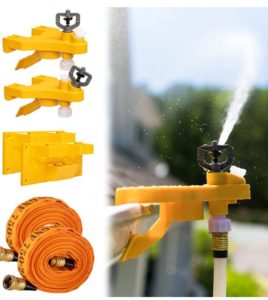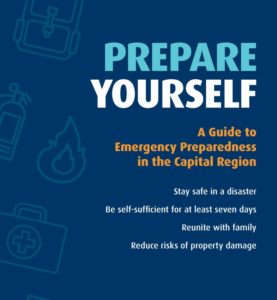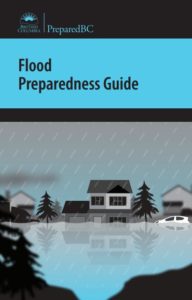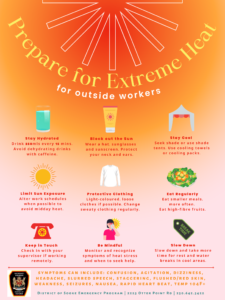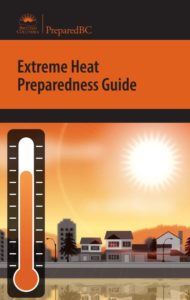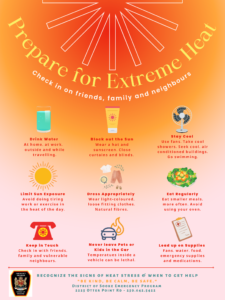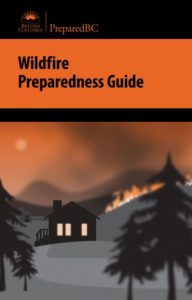Sooke Emergency Program
Updated December 12, 2023
Sooke Emergency program is a division of Sooke Fire Rescue. The Sooke Emergency program supports municipal efforts to prepare for, respond to and recover from emergencies and disasters. The Emergency Program:
- ensure continuity of services and in government.
- provides a plan for preserving life and property.
- Coordinates responses from elected officials, municipal service areas, volunteer services and outside agencies.
When a community member needs assistance or an emergency takes place, the Sooke Fire Department, Sooke R.C.M.P. and Emergency Program Personnel, comprised of numerous agencies, are ready to assist. There are different levels of emergency. When it comes to community-wide emergencies, such as a threat of a wildfire, through the District’s emergency program, we have an excellent team of professional and volunteer emergency responders. However, it is the combined effort of all in the community that will ensure resiliency through such an event.
Public Alert Notification System
During an emergency or significant event, it is important to seek local information. Threats and subsequent actions can differ according to a geographic location – even within the Greater Victoria region. The District of Sooke has partnered with the CRD on their Public Alert Notification System (PANS). Sooke residents are encouraged to register to receive Sooke-specific emergency-related public alert notifications by phone, text, or email. SIGN UP HERE >>
Emergency Planning
Is your household prepared? We all have a role to play in supporting our community, and for the safety of your household, it is important that you have a grab-and-go emergency kit with supplies for three to seven days to support your family.
- A Guide to Emergency Preparedness in the Capital Region (PDF)
- Emergency Management BC (EMBC): Emergency Preparedness, Response & Recovery in BC
- PreparedBC: British Columbia’s one-stop-shop for disaster readiness information – prepare and download helpful guides
- Get FireSmart (your home and property) and gather valuable preparedness resources for individuals, families, pets and businesses.
- LEARN MORE ABOUT EMERGENCY PREPAREDNESS AND EVACUATION PROTOCOLS >>
Build a household emergency kit and grab-and-go bag
Following a disaster, you may need to stay at home with your emergency kit or leave immediately with your grab-and-go bags. Gather and organize your emergency supplies now so you’re ready when disaster strikes.
Building your emergency kit or grab-and-go bag doesn’t need to be expensive or take a lot of time. Follow the basic supply lists below. Just remember to consider the unique needs of your household, such as including items for pets (PDF) or seniors.
Emergency Kit Supplies
Put your supplies in one or two containers, such as plastic bins or duffel bags. Store them in an area of your home that’s easy to get to, such as a hall closet, spare room or garage.
- Non-perishable food: three-day to one-week supply, with a manual can opener
- Water: four litres per person, per day for drinking and sanitation
- Phone charger, battery bank or inverter
- Battery-powered or hand-crank radio
- Battery-powered or hand-crank flashlight
- Extra batteries
- First-aid kit and medications
- Personal toiletries and items, such as an extra pair of glasses or contact lenses
- Copy of your emergency plan, copies of important documents, such as insurance papers
- Cash in small bills
- Garbage bags and moist towelettes for personal sanitation
- Seasonal clothing, sturdy footwear and emergency blanket
- Dust masks if you live in an area that’s prone to earthquakes
- Whistle
- Help/OK Sign (PDF): Display the appropriate side outward in your window during a disaster.
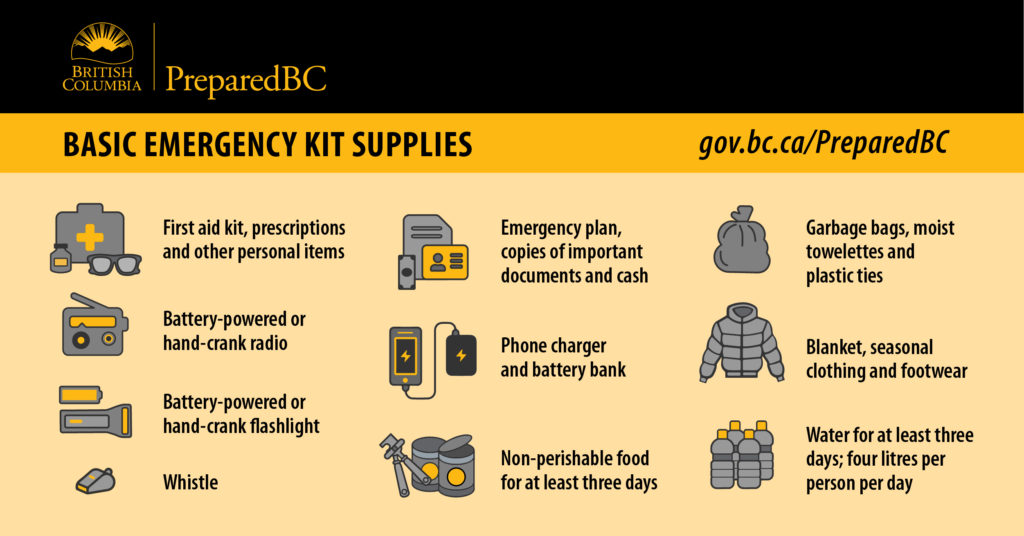
Build a Grab-and-go Bag
You may need to leave immediately in the event of an emergency. Be ready to go by having a smaller version of your emergency kit in an easy-to-access place in your home. In addition to having one at home, create grab-and-go bags for your workplace and vehicles that contain:
- Food (ready to eat) and water
- Phone charger and battery bank
- Small battery-powered or hand-crank radio
- Battery-powered or hand-crank flashlight
- Extra batteries
- Small first-aid kit and personal medications
- Personal toiletries and items, such as an extra pair of glasses or contact lenses
- Copy of your emergency plan, copies of important documents, such as insurance papers
- Cash in small bills
- Local map with your family meeting place identified
- Seasonal clothing and an emergency blanket
- Pen and notepad
- Whistle
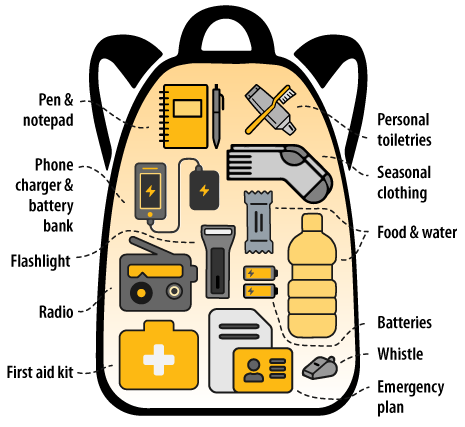
During an emergency or significant event, it is important to seek local information. Threats and subsequent actions can differ according to a geographic location – even within the Greater Victoria region. The District of Sooke has partnered with the CRD on their Public Alert Notification System (PANS). Sooke residents are encouraged to register to receive Sooke-specific emergency-related public alert notifications by phone, text, or email. SIGN UP HERE >>
Please note: As required by the Canadian Radio-television and Telecommunications Commission (CRTC) any alerts sent via Alert Ready (the Wireless Public Alerting System provided by the Provincial and Federal Government) will take precedence over any notifications you receive via the Public Alert Notification System. Read more >>
Download the FREE Alertable app for iOS and Android smartphones. Install the FREE Alertable skill and action for Amazon Alexa and Google Assistant home devices. Sign up for FREE and or phone calls. Follow Alertable on Facebook and Twitter. Connect with Alertable directly on Facebook Messenger. Get desktop and browser notifications from Alertable.ca. Install the FREE Alertable add-on for Slack and Microsoft Teams (coming soon). Choose any combination that’s right for you.
Notifications are fast, reliable and easy to see and hear. Personalize notifications by type and severity. Choose notifications for more than one location such as home, office, cottage, family and friends and more. Please SHARE!
LEARN MORE & FIND ALERTABLE FAQS HERE >>
Emergencies can be defined as situations caused by the forces of nature, an accident, or an intentional act that constitutes a danger of major proportions to life or property. Whenever an emergency occurs, which affects the lives and property of citizens, the initial and prime responsibility for providing immediate assistance rests with the local municipal government. The District of Sooke emergency plan is designed to ensure the coordination of municipal, private and volunteer services during an emergency, to bring the situation under control as quickly as possible.
In order to protect residents, businesses and visitors, the District of Sooke require a coordinated emergency response by a number of agencies. The District of Sooke has prepared an emergency response and business continuity plan, which contains distinct arrangements and procedures that are different from the normal day-to-day operations, to ensure that every official, municipal department and partner agency will be prepared to carry out assigned responsibilities in an emergency.
All municipal officials of the District of Sooke, whether elected or appointed, must be fully conversant with the contents of this emergency plan and be prepared at all times to carry out the duties and responsibilities allotted to them. In addition, it is important that residents, businesses and interested visitors be aware of its provisions.
- Emergency Response and Business Continuity Plan 2013
- Emergency Operations Centre Manual 2013
- Emergency Program Bylaw
The Emergency Weather Response (EWR) Shelter during cold weather and storm events in Sooke is at the CRD Building on Butler. Activation of EWR is made by the Sooke Shelter Society at 11 am each day pending weather and staffing with notice posted on their Facebook page. When activated, transportation is arranged:
-
- to leave The Hope Centre at 7pm
- to return persons from the CRD building to the Sooke town core at 7am.
Public spaces such as the library and SEAPARC serve as warming and cooling centres.
Flooding and storm surges in our region bring high water and waves. When combined with high tides (especially King Tides) these conditions can create storm surges which can cause flooding and coastal erosion. As the sea level is expected to rise over the next century, it is expected that storm surges will flood areas not previously impacted, affecting near-shore development. Properties in flood inundation zones (near rivers and ocean shorelines) in Sooke are the highly susceptible. Homes can also be affected by surface and overland water runoff. Prepare for potential flooding and marine impacts proactively.
- Source sandbags in advance from the community sandbag station
- Help keep drains and catch basins clear
- Do not drive through deep, standing water and avoid fast-moving water
- Refresh your grab & go bag and your shelter in place kit
- Review and practice your family emergency plan
The WASP Patented Gutter Mount Sprinkler System gets water to the home’s roof and surrounding areas, where it’s needed most during wildfire emergencies. Homeowners can now purchase the gutter mount sprinkler system, which had previously only been available to the firefighting community. The District of Sooke Fire Department makes kits available to local residents. Purchase at the Sooke Fire Hall at 2225 Otter Point Road or the Sooke Municipal Hall at 2205 Otter Point Road.
Severe weather can develop quickly and include events such as blizzards, hail, heavy rain, ice storms, thunderstorms, storm surges and high winds. Severe weather events are expected to increase in our region over the next fifty years due to a changing climate. These events can cause power outages, so it makes sense to get prepared.
- Have flashlights and batteries ready to go
- Stock up on ready-to-eat food and water
- Refresh your grab & go bag and your shelter-in-place kit
- Review and practice your family emergency plan
- Check the BC Hydro Outage list (bchydro.com) for updates
Safety first! Never go near or touch a fallen power line. Always assume that a line or anything it is in contact with, is energized. Stay at least 10 metres (33 feet) away at all times and do not attempt to remove debris surrounding the line. If you see a fallen power line, report the exact location to 1.888.POWERON (1.888.769.3766).
PREPARING FOR AN OUTAGE
- Have an emergency plan, your grab & go bag and your shelter-in-place kit ready.
- Choose manual equipment like basic can openers, non-electric phones, battery, wind-up or solar-powered radios, and a handsaw for your emergency kit.
- Have safe, stable sources of light, such as flashlights, in your emergency kits.
- People who rely on life-sustaining equipment should contact their local health provider and consider purchasing or arranging to rent a small generator on a priority basis.
- Stock up on fuel for barbecues and camp stoves. Store appliances and fuel safely and use outdoors only.
- If you have an electric garage door opener, learn how to open the garage door manually. Follow the instructions supplied by the manufacturer.
DURING AN OUTAGE
- Check whether the power failure is limited to your home. If your neighbour’s power is still on, check your circuit breaker panel or fuse box.
- Call BC Hydro at 1.888.POWERON (1.888.769.3766) or *HYDRO (*49376) on your cell phone. Tell them about the outage so they can send the right crews and equipment to the correct location.
- Tune in to your local radio station for storm and power outage updates.
- Turn off all appliances, including home computers and peripherals, especially those that generate heat. This helps prevent hazards or damage when service is restored. Use surge protectors to protect sensitive electrical equipment such as computers and TVs.
- Turn off all lights except for one inside your home and one outside. The inside light lets you know, and the outside light lets BC Hydro crews know when the power is back on.
Portable Generator Safety Precautions
Prevent carbon monoxide poisoning: Carbon monoxide (CO) is a colourless, odourless gas in the engine exhaust of a generator and BBQs. You may not smell the exhaust but could still be exposed to CO, so never use them indoors
- Never use a portable generator indoors, including inside a garage or other enclosed or partially enclosed area, to avoid carbon monoxide (CO) poisoning.
- Only operate portable generators outdoors and at a location where the exhaust cannot enter your home or other buildings through doors or windows.
- If you start to feel dizzy, nauseous, get a headache or feel tired while using a generator, get to fresh air immediately and seek medical attention.
- Install a CO alarm in your home.
- Never plug a portable generator into a regular household electrical outlet as it can cause fire and back-feeding to the BC Hydro electrical grid and cause electrocution to utility workers, your neighbours and your household.
- Plug appliances directly into the generator or use a heavy-duty, outdoor-rated, CSA-approved 3-pronged extension cord in good condition.
- Use a Ground Fault Circuit Interrupter (GFCI) portable extension cord if using the portable generator to power electrical tools for outdoor use.
- Keep the generator dry and protected with a tarp when using in rain and snow.
- Learn how to use your generator before you need it. Follow the manufacturer’s recommended usage.
The community sandbag station is located in the parking lot beside Ed McGregor Park at 6751 West Coast Road. The station is self-serve, open 24 hours a day – seven days a week, and sand and bags are provided by the District and Emergency Management British Columbia. Residents are asked to bring their own shovels to fill the bags and are encouraged to take only enough to meet their needs so that supplies are available for others.
Emergency Contacts:
- For an Emergency with respect to fire or life safety, please call 911
- Sooke Fire Department: 250.642.5422
- Sooke RCMP Detachment – non-emergency: 250.642.5241
- Air or Marine Emergency: 1.800.567.5111
- Provincial Emergency Program: 1.800.885.6655 (Earthquake, Flood, Tsunami, Dangerous Goods Spilled, Coastal Watch – suspected illegal activities at sea).
- Poison Control Centre: 250.595.9211
- Victoria General Hospital: 250.727.4212, #1 Hospital Way, Victoria, BC, V8Z 6R5
Resources
Printable resources – comprehensive emergency preparedness guide & flood preparedness guide
Printable tips and resources for residents and outside workers to prepare and stay cool during extreme heat:
Wildfire Preparedness – FireSmart your Property
Printable tips and resources for wildfire preparedness and creating a FireSmart property:
FireSmarting your property will dramatically decrease the risk of wildfire burning down your home. The best part is, it’s surprisingly easy to do. Check out the list of top 10 ways to FireSmart your home:
Printable Tip sheet:
- Move firewood 10–30 metres from your home
- Clean your roof and gutters of leaves & pine needles
- Have a wildfire evacuation plan with your household
- Keep grass cut to less than 10 cm
- Trim and prune any trees or vegetation that overhang your roof
- Take inventory of what kind of trees grow on your property. (Some trees are more flammable, such as Pine. Other trees are more resistant to fires, such as birch and aspen.)
- Make sure everyone in your family knows where the gas, electric, and water mains shut-off are!
- Assess your roof and chimney. Is your roof clean? Do you have a spark arrestor? Having a clean, protected roof can significantly improve the chances of the entire structure surviving.
- Relocate propane tanks 10-30 meters from your home
- Conduct a full FireSmart assessment of your home and property. Download the FireSmart Homeowner’s Manual to assess and FireSmart your home.
Take the FREE online FireSmart 101 Course presented by FireSmart BC.
